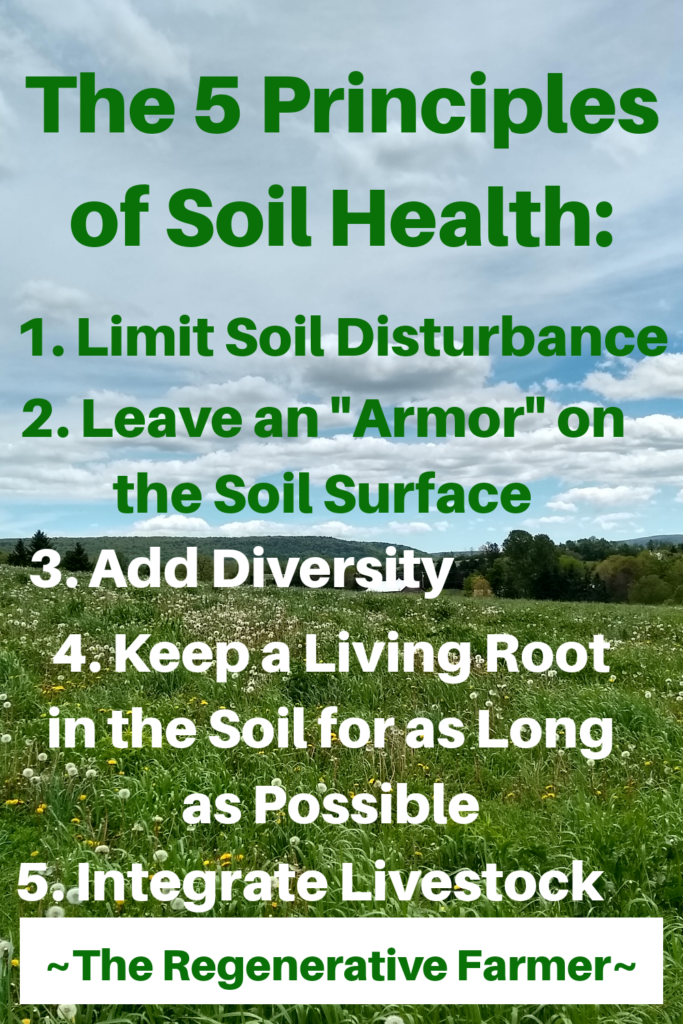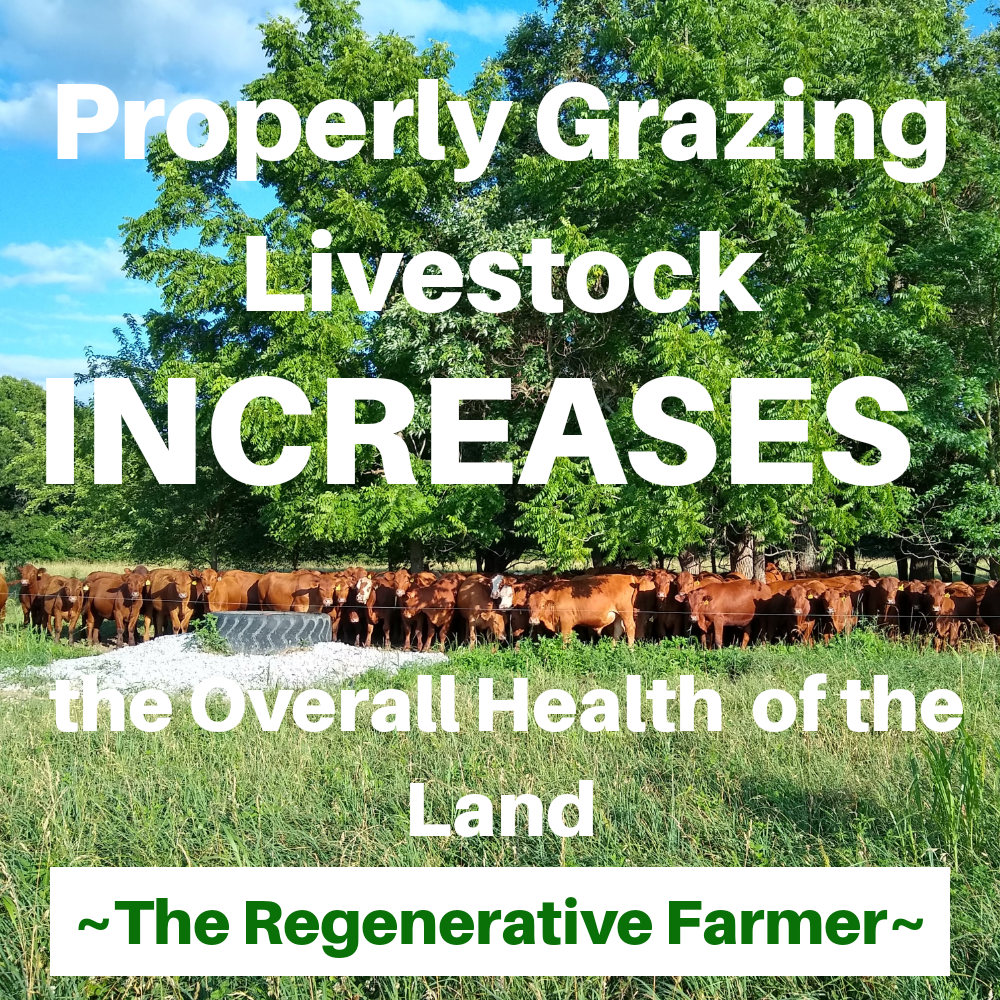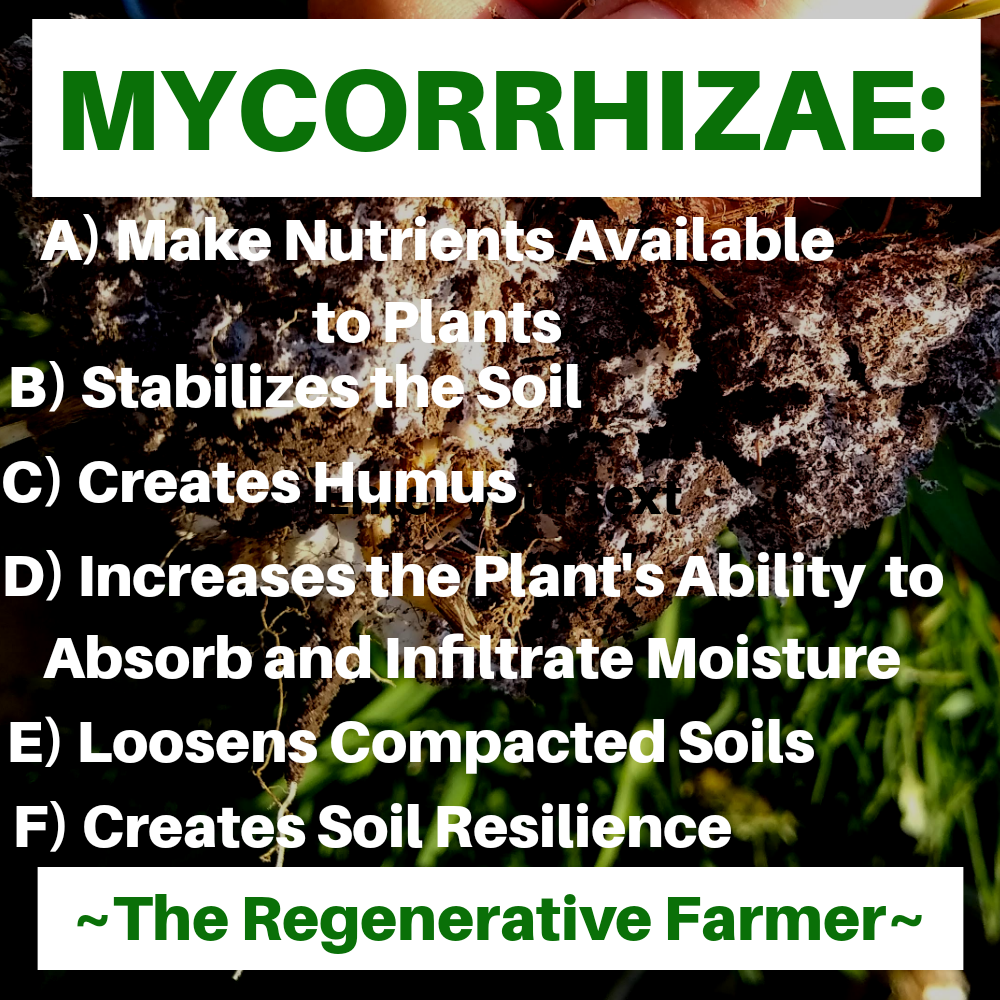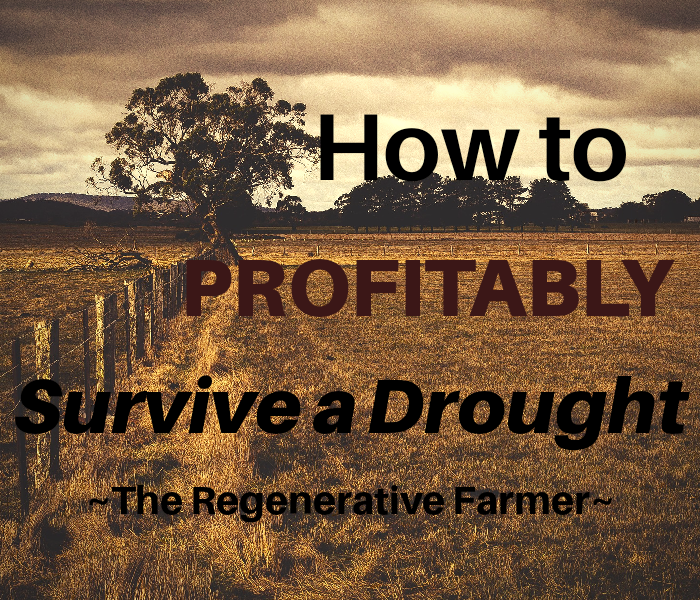A drought can be serious business. In some cases, your whole business depends on whether or not you survive it. This article will walk you through the steps that will ensure that you can survive heavy dry spells while:
a) still making money, and
b) maintaining ecological health on your operation
…all by investing in your soil’s ability to effectively collect, store, and utilize moisture.
Making the Most Out of Your Available Moisture
A drought isn’t about how much less rain there is – it’s how effectively it can be stored and utilized in the soil. A poor water cycle does not store moisture efficiently; a healthy water cycle is just the opposite.
In order to to survive a drought, it is imperative to make the most out of every drop of water.
This begins by ensuring that you have a functioning water cycle. A healthy water cycle mirrors a healthy soil – if you’re not getting good infiltration or water storage, your soil is unhealthy.
In order for you to get a basic understanding on how soil health affects the water cycle, you need to know how a healthy soil functions.
So, without further ado, here’s a basic explanation of how a healthy soil functions:
Plants and mycorrhizae form a mutual relationship with each other in a healthy soil – when plants need a specific mineral/nutrient, they will send out specific signals to specific microbes for those nutrients. In return, the microbes break down organic matter and deliver the nutrients to the plants. In exchange for those nutrients, the plants leak carbon rich exudates to the microbes, who then feed on it.
When the population of the microbes has reached a certain density, they begin quorum sensing, which induces the growth, health and defense of the plants supplying them with exudates.
Mycorrhizal fungi are responsible for creating glomalin, a product that binds soil particles. This binding of soil particles creates pore spaces. More aggregated particles means better water infiltration and pores for air. In those soil pores are where the microbes dwell in a thin “sheet” of water.
Healthy microbes that utilize root exudates play a key role in the creation of humus, a carbon and nutrient rich substance that effectively increases the soil’s ability to collect and store moisture.
By investing in soil health, you’re investing in the favorable conditions for microbes to create pores, advance plant resilience, and build humus. THIS IS KEY FOR YOUR FARM’S SURVIVAL IN THE NEXT DROUGHT.
Understanding Soil Health
By now, you should know that a healthy water cycle = a healthy soil. In order to build resilience to drought in your soil, you need to understand the principles of soil health. When you have a healthy soil, you’ll have a healthy water cycle.

Photo and image taken/created by Isaiah Graves.
The Regenerative Farmer
There are five established principles of soil health, and they are:
- Limit soil disturbance
- Leave an “armor” on the soil surface
- Add diversity
- Keep a living root in the soil for as long as possible
- Integrate livestock
(Want to learn more about the five principles of soil health? My article, “The 5 Crucial Principles of Soil Health” further explains these principles in detail.)
I’ll try to summarize the principles of soil health here in a nutshell:
- Limit soil disturbance – The use of constant physical disturbance (think tillage and plowing), and chemical disturbance on a regular scale demolishes microbe populations and decreases organic matter content, promoting eroding and very non-effective soils for moisture storage. We want to limit disturbance to increase microbe productivity.
- Leave an “armor” on the soil surface – An armor (I like to think of it as a skin) of organic matter on the soil surface halts erosion and runoff and provides a shelter/material source for the beneficial microbe populations, who then convert part of it into humus.
- Add diversity – The more diverse your plant life, the more diverse the root exudates that are fed to the microbes; more microbes means more soil aggregates and hummus, which translates to better water infiltration and moisture storage. Different plants also attracts/hosts different beneficial insects that keep the ecosystem in balance.
- Keep a living root in the soil for as long as possible – The longer you keep a root growing inside the soil, the longer microbes are being fed and are creating aggregates and humus.
- Integrate livestock – Properly grazed livestock stimulate microbe populations and productivity when they graze plants; plants need more nutrients to regrow leaves/roots, so they signal and trade in exudates to obtain those nutrients. More exudates means more microbes, greater water storage, infiltration, etc.
(A fantastic book that will help further your farm’s resilience during periods of drought is Dale Strickler’s book, “The Drought Resilient Farm.” In it, Dale covers creating a moisture efficient soil and providing for livestock during drought. It is truly a insightful piece of knowledge that anyone who either makes a living based on soil health or grows food from it will benefit from. I highly recommend it!)
Making a Drought Resilient Soil a Reality
Your next step to creating a healthy soil (which in turn creates a healthy water cycle) is to implement the practices that create it.
Some effective soil-enhancing practices that you can utilize (under the five principles of soil health) are: maintaining diverse plant life, no-tilling, and using livestock.
Utilizing Diverse Plant Life
Let’s talk about diverse plant life for a bit.
By using a diverse stand of plants (cover crops are just one example), you can greatly increase your soil’s capacity to store moisture. There are many reasons for this; I will explain a few of them below.
The first is that decaying roots contribute to the accumulation of organic matter and water infiltration in the soil.
For example, radishes, chicory, and other deep-rooted plants are helpful not only in bringing nutrients up from the subsoil, but by also creating deep channels that promote water infiltration (with the added benefit of feeding soil microbes). Additionally, a diversity in root lengths means all the more influence that mycorrhizae can have on the deeper layers of soil, increasing the beneficial effects of mycorrhizae (this includes better water infiltration/storage).
The second reason is that a greater variety of plants results in a greater variety in exudates that are fed to the microbes (this helps feed and boost microbial populations).
The third is that you can have a living root in the soil all year round. Managed correctly, you can have season appropriate plants in your pastures, gardens, or fields that are constantly pumping liquid carbon (exudates) into the soil to feed microbes.
(And why wouldn’t we want to feed our microbes? If we wouldn’t let our livestock go without feed a whole winter, why would we let our microbial livestock go hungry?)
Going No-Till
By going to no-till, you’re keeping the soil aggregates and the biotic glues that bind them together stable. Stable aggregates means improved water infiltration.
Plowing, by contrast (or most other methods of soil disturbance for that matter) destroys aggregates and increases bacterial populations that consume the biotic glues and organic matter that holds the aggregates together. (This is NOT desirable, as it decreases the amount of moisture we can infiltrate and store, as well as promoting erosion. Although the reason behind plowing is that it increases water infiltration, the results have consistently proven the opposite! The two videos below are absolutely mind-blowing. Soil slake test: Link. Rainfall simulator: Link).
Using Livestock
Not every operation has a place or need for livestock, but understanding the potential they possess in creating a water efficient soil is crucial.
(If you’re interested in any more information on the benefits of livestock, you can read my article 5 Reasons to Integrate Livestock for Better Health and Profits here.)
There are a few ways that livestock can improve your soil, and one of the most powerful (and most unorthodox of ideas) is how and when they graze.

Photo and image taken/created by Isaiah Graves.
The Regenerative Farmer
When livestock are properly grazed in a high-density, short-duration grazing system, (imitating the wild herding herbivores of centuries past) they actually increase overall community health. Correctly planned and applied to the appropriate environment, it increases the effectiveness of the water, energy, and mineral cycles, and enhances its community dynamics.
When plants are grazed, they consider the removal of their leaves equivalent to a wound. In order to acquire the nutrients it needs to grow back, it collaborates with the soil biology – trading in carbon-rich root exudates for the nutrients.
If you remember, those carbon rich exudates are what feed the microbes – and the microbes create pores, advance plant resilience, and build water-storing humus.
It’s that simple: well-managed grazing will definitely create a healthy soil and an effective water cycle.
(The research put into effective grazing is due to Allan Savory and his team, who have pioneered Holistic Management and Holistic Planned Grazing. I highly recommend his book, Holistic Management: A Commonsense Revolution to Restore our Environment [the 3rd edition] to everyone. You can learn more about Holistic Management at https://www.savory.global .)
But Wait, there’s More…
Livestock can do more than just grazing to improve your soil. During the dormant months when plant growth is absent, feeding livestock baled hay on your pasture/field presents itself as an effective way to add fertility and organic matter to your soil.
Basically, there a two slightly different methods of bale feeding: You have spaced bale feeding and bale grazing.
With spaced bale feeding, bales are set apart 30×30’ apart in a grid-like pattern, and polywire is used to fence off only a single day’s worth of feed at a time. The next day, the polywire is moved forward to expose another day’s worth of feed, and so on. Spaced bale feeding results in five times the organic matter and minerals that are provided to the soil than bale feeding does.
Dale Strickler, author of The Drought Resilient Farm, says that it is the single fastest technique he knows to raise soil organic matter on a field scale.
(Strickler, Dale. The Drought Resilient Farm. Storey Publishing, pgs 22-24)
Bale grazing, on the other hand, is accomplished by unrolling a day’s worth of baled hay with the unrolled strips being approximately 20 feet apart.
Both methods are effective at increasing organic matter and nutrients, however spaced bale feeding presents itself as one that is less labor and energy consuming, as well as depositing more nutrients on the ground.
Similarly, small-scale farmers and homesteaders could practice their own modified form of bale feeding/bale grazing for their own operations. (I have personally experienced this first hand – I’ve often bale bale grazed with my family’s two Jersey cows, and I can confidently say that every time you feed hay on a patch of ground, there is a positive difference in the plants’ health and vigor the following year.)
Just as a reminder, you can have a diversity in plant life and you can no-till, but as long as the first four principles of soil health in the very least are NOT being followed, you will not profit out of your endeavors.
Utilizing Your Rainfall Effectively
So far we’ve discussed how you can build your soil health to create a functional water cycle. Soil health mirrors a healthy water cycle; with it, you can effectively infiltrate and store the moisture that is available to you.
But what are some of the ways you can have your plants utilize it effectively?
No matter what operation you run, every single producer of solar dollars can benefit from two or more of the following:
- Ensuring that plants have the nutrients they need
- Following the 5 principles of soil health
- Utilizing warm-season (C4) plants
Ensuring that Plants Have the Nutrients they Need
Studies have shown that plants that have their appropriate nutrient requirements (like nitrogen) have proven to be more water efficient. By making sure that our plants have the trace minerals and nutrients they need, they will make better use of any water available to them in times of drought.
(Strickler, Dale. The Drought Resilient Farm. Storey Publishing, pg 73).
Following the 5 Principles of Soil Health
By following the 5 principles of soil health, we are promoting the health and production of mycorrhizal fungi.
Mycorrhizae not only provide nutrients to plants, stabilize the soil, and create humus, but also increase the ability of plants to absorb water from the soil. Mycorrhizae also help loosen compacted soils.

Photo and image taken/created by by Isaiah Graves.
The Regenerative Farmer
Take this, for example:
- Hyphae (the branching filaments that make up the mycelium of the fungi) increase the absorption of water 1,000 times greater in comparison to an uncolonized root, and extend up to 24” past the root zone
- Hyphae, due to their small diameter, can extend into pore spaces that are inaccessible for root hairs, which allows for greater water uptake
- The glomalin that hyphae produce allows them to breach compacted soil layers
- Hyphae can exert a mechanical force nearly 10 times greater that plant roots to break through mechanically compacted soils
(Strickler, Dale. The Drought Resilient Farm. Storey Publishing, pg 74.)
This shows us how important soil biology is to our plants’ health and wellbeing. If you want a thriving and profitable landbase, start with the 5 principles of soil health!
Utilizing Warm-Season Plants (C4’s)
*This is a classic example of the need for diversity*
(Generally, farmers who produce forage for livestock will find this section most applicable.)
Different plants thrive during different times of the year. Warm season plants (also known as C4’s- I’ll explain this in a bit) and cool season plants (also C3’s) both have their own beneficial traits during their growing seasons.
The Difference Between C3 and C4 Plants…
(The “C3” or “C4” represents the number of carbon atoms present in the first product of photosynthesis in the pathway. According to Dale Strickler, “The photosynthesis process consists of two parts: the light reactions, which require light, and the dark reactions, which do not require light. The light reactions involve the splitting of water into hydrogen and oxygen. The hydrogen is used in the dark reactions, while oxygen is a waste product…The dark reactions involve the combining of carbon dioxide and hydrogen (from the light reactions) into glucose.” [Strickler, Dale. The Drought Resilient Farm. Storey Publishing, pg 100.]
C3 plants have their light and dark reactions take place in the same cells. This allows an easy transportation of hydrogen from the light reactions to the dark reactions. When sunlight is abundant and temperatures rise, the light reactions occur at an increased speed. Eventually, so much oxygen is building up in the cell that the enzyme in control of seizing the CO2 will accidently grab the oxygen instead, which does not create glucose. This is known as photorespiration.
C4 plants by contrast, have the light reactions and dark reactions take place in separate cells, with the light reactions occurring near the leaf’s surface, and the dark reactions in the bundle sheath cells. The result is a plant without photorespiration, which allows them to thrive in hot and sunny weather.
[Strickler, Dale. The Drought Resilient Farm. Storey Publishing, pgs 100-101.])
Utilizing warm season plants in areas with hot spells is a smart move to provide quality forage that is water efficient. C4 plants can produce three times the daily biomass that a C3 plant can when it’s hot and sunny, and only require one third of the water to produce a single pound of dry matter. (Strickler, Dale. The Drought Resilient Farm. Storey Publishing, pgs 100-102.)
Seeding pastures with both cool season and warm season plants allows each species to produce an optimal amount of forage in the opposite species’ dormant season.
Conclusion
As producers of food, fiber, and energy products, we will always experience a drought at some point. They are a part of life.
Investing in our soil’s ability to collect and store moisture is one effective way that we can make it through and still produce a profit.
Basically, every one of the ideas listed in this article fall under the 5 principles of soil health:
- Limit soil disturbance
- Leave an “armor” on the soil surface
- Add diversity
- Keep a living root in the soil for as long as possible
- Integrate livestock
If we decide to enrich our soils and apply these 5 principles of soil health, we will benefit out of our endeavors.
Remember: you can do one or more of the principles of soil health, but as long as the first four are NOT being followed, don’t expect to see major improvement.
If you’re interested in more information to further your farm’s resilience during periods of drought, I would highly recommend Dale Strickler’s book, “The Drought Resilient Farm.” In it, Dale covers creating a moisture efficient soil and providing for livestock during drought. It is truly a insightful piece of knowledge! Anyone who makes a living based on soil health or grows food from it will benefit from his book.
Thanks for reading!
Until next time,
~ Isaiah

